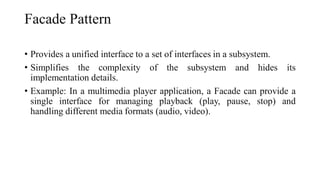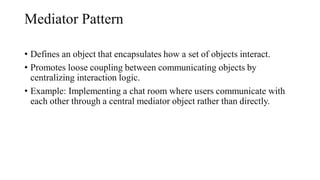software engineering Design Patterns.pdf
- 2. Creational Design Patterns Creational design patterns focus on object creation mechanisms. They provide flexibility and encapsulation in object creation processes. Creational patterns address various requirements, such as: • Controlling object instantiation • Enhancing flexibility in creating objects • Promoting reuse and configurability Example: Singleton, Factory Method, Abstract Factory, Builder, Prototype
- 3. Singleton Pattern • Ensures a class has only one instance and provides a global point of access to that instance. • Commonly used for logging, database connections, and configuration settings. • Example: In a logging system, the Singleton pattern ensures there's only one instance of the logger object shared across the application.
- 4. Factory Method Pattern • Defines an interface for creating objects, but subclasses decide which class to instantiate. • Encapsulates object creation logic in subclasses. • Example: In a vehicle manufacturing system, the Factory Method pattern allows each vehicle type (car, bike, truck) to have its factory method for creating instances.
- 5. Abstract Factory Pattern • Provides an interface for creating families of related or dependent objects without specifying their concrete classes. • Encourages loose coupling between client code and concrete classes. • Example: In a GUI framework, an abstract factory can create different types of buttons, text boxes, and dropdowns for various operating systems (Windows, macOS, Linux).
- 6. Builder Pattern • Separates the construction of a complex object from its representation, allowing the same construction process to create different representations. • Supports the creation of objects with varied configurations. • Example: In a meal ordering system, the Builder pattern can be used to construct different types of meals (e.g., vegetarian, non-vegetarian) with customizable options (e.g., size, toppings). •
- 7. Prototype Pattern • Creates new objects by copying an existing instance, known as the prototype. • Avoids the need for subclassing to create new objects. • Example: In a graphic design tool, the Prototype pattern allows users to clone existing shapes and modify them to create new shapes without having to define a new class for each variation.
- 8. Structural Design Patterns • Structural design patterns focus on class and object composition. • They enhance code organization, flexibility, and reusability. • Structural patterns describe how objects and classes can be combined to form larger structures. • Example: Adapter, Bridge, Composite, Decorator, Facade, Flyweight, Proxy.
- 9. Adapter Pattern • Allows incompatible interfaces to work together by providing a bridge between them. • Translates one interface into another without changing the existing code. • Example: Adapting a third-party payment gateway interface to work with an existing e-commerce system by implementing an adapter that converts the gateway's interface into a standard interface expected by the system.
- 10. Bridge Pattern • Decouples an abstraction from its implementation, allowing them to vary independently. • Provides flexibility in designing large systems by separating abstractions from their implementations. • Example: In a drawing application, the Bridge pattern separates the shape abstraction (e.g., circle, square) from its rendering implementation (e.g., OpenGL, DirectX).
- 11. Composite Pattern • Composes objects into tree structures to represent part-whole hierarchies. • Allows clients to treat individual objects and compositions of objects uniformly. • Example: In a file system, files and directories can be represented as leaf and composite components, respectively, allowing recursive operations to be performed on the entire structure.
- 12. Decorator Pattern • Attaches additional responsibilities to objects dynamically. • Provides a flexible alternative to subclassing for extending functionality. • Example: In a text processing application, the Decorator pattern allows text formatting decorators (e.g., bold, italic) to be applied to a base text object, enabling the creation of rich-text documents.
- 13. Facade Pattern • Provides a unified interface to a set of interfaces in a subsystem. • Simplifies the complexity of the subsystem and hides its implementation details. • Example: In a multimedia player application, a Facade can provide a single interface for managing playback (play, pause, stop) and handling different media formats (audio, video).
- 14. Flyweight Pattern • Minimizes memory usage or computational expenses by sharing as much as possible with related objects. • Stores common and intrinsic states externally and shares them among multiple objects. • Example: In a text editing application, the Flyweight pattern can be used to store shared font styles (e.g., Arial, Times New Roman) and reuse them across multiple text objects.
- 15. Proxy Pattern • Provides a placeholder for another object to control access, reduce cost, or add functionality. • Acts as a surrogate or placeholder for the real object. • Example: In a remote service invocation system, a Proxy can represent a remote object and handle communication details such as network communication and authentication. •
- 16. Behavioral Design Patterns • Behavioral design patterns focus on communication between objects and their responsibilities. • They address how objects interact and fulfill individual responsibilities. • Behavioral patterns promote flexibility, modularity, and extensibility in software design. • Example: Observer, Strategy, Chain of Responsibility, Command, State, Interpreter, Mediator, Memento, Visitor.
- 17. Observer Pattern • Defines a one-to-many dependency between objects, ensuring that when one object changes state, all its dependents are notified and updated automatically. • Enables loose coupling between subjects and observers. • Example: In a weather monitoring system, the Observer pattern allows multiple weather displays to be updated whenever the weather conditions change, ensuring real-time data synchronization.
- 18. Strategy Pattern • Defines a family of algorithms, encapsulates each one, and makes them interchangeable. • Allows algorithms to vary independently from clients that use them. • Example: In a payment processing system, the Strategy pattern enables different payment methods (e.g., credit card, PayPal) to be encapsulated as strategies, which can be selected dynamically based on user preferences.
- 19. Chain of Responsibility Pattern • Allows multiple objects to handle a request without the sender needing to know which object will handle it. • Forms a chain of handler objects, each processing the request or passing it to the next handler in the chain. • Example: In an approval workflow system, the Chain of Responsibility pattern can be used to create a sequence of approvers (e.g., manager, director, CEO) where each approver decides whether to approve or forward the request to the next level. •
- 20. Command Pattern • Encapsulates a request as an object, thereby allowing for parameterization of clients with queues, requests, and operations. • Enables the invocation of commands without knowing the requested operation or the receiver's identity. • Example: In a remote control application, the Command pattern encapsulates various device actions (e.g., turn on, turn off, change channel) as command objects, allowing users to queue and execute commands sequentially.
- 21. Interpreter Pattern • Defines a grammar for interpreting a language and provides a way to evaluate sentences in that language. • Used to represent and evaluate simple grammatical expressions. • Example: Parsing and evaluating mathematical expressions provided as strings.
- 22. Iterator Pattern • Provides a way to access elements of an aggregate object sequentially without exposing its underlying representation. • Enables traversal of collections without knowing their internal structure. • Example: Iterating over the elements of a list, array, or tree data structure without exposing the details of their implementation.
- 23. Mediator Pattern • Defines an object that encapsulates how a set of objects interact. • Promotes loose coupling between communicating objects by centralizing interaction logic. • Example: Implementing a chat room where users communicate with each other through a central mediator object rather than directly.
- 24. Memento Pattern • Captures and externalizes an object's internal state so that the object can be restored to this state later. • Allows for undo/redo functionality and restoring an object to a previous state. • Example: Implementing undo functionality in a text editor to revert changes made to a document.
- 25. State Pattern • Allows an object to alter its behavior when its internal state changes. • Encapsulates state-specific behavior into separate state objects. • Example: Implementing a vending machine where its behavior changes based on its current state (e.g., idle, dispensing, out of stock).
- 26. Template Method Pattern • The Template Method pattern defines the skeleton of an algorithm in a method, deferring some steps to subclasses. • Allows subclasses to redefine certain steps of an algorithm without changing its structure. • Encourages code reuse and ensures consistency in algorithm behavior across subclasses. • Example: In a document processing application, the Template Method pattern can be used to define a common process for opening, editing, and saving documents, with specific steps (e.g., file format conversion) implemented by subclasses for different document types.
- 27. Visitor • The Visitor pattern is a behavioral design pattern that allows adding new operations to existing classes without modifying their structure. • It separates the algorithm from the object structure on which it operates. • Enables performing operations on a group of related objects with different concrete implementations. • Useful when the structure of objects is stable but the operations on them vary and need to be added or changed over time.



























